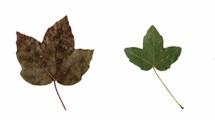Abstract
The identification of plant species is fundamental for effective study and management of biodiversity. For automated plant species classification, a combination of leaf features like shapes, texture and color are commonly used. However, in herbariums, the samples collected for each species are often limited and during preservation step some of the feature details disappear making automated classification a challenging task. In this study, we aimed at applying machine learning techniques in automating herbarium species identification from leaf traits extracted from images of the families Annonaceae, Euphorbiaceae and Dipterocarpaceae. Furthermore, we investigated the application of Synthetic Minority Over-sampling Technique (SMOTE) in improving classifier performance on the imbalance datasets. Three machine learning techniques namely Linear Discriminant Analysis (LDA), Random Forest (RF) and Support Vector Machine (SVM) were applied with/without SMOTE. For Annonaceae species, the best accuracy was 56% by LDA after applying SMOTE. For Euphorbiaceae, the best accuracy was 79% by SVM without SMOTE. For inter-species classification between Annonaceae and Euphorbiaceae, the best accuracy of 63% was achieved by LDA without SMOTE. An accuracy of 85% was achieved by LDA for Dipterocarpaceae species while 91% accuracy was obtained by both RF and SVM for inter-family classification between the two balanced datasets of Annonaceae and Euphorbiaceae. The results of this study show the feasibility of using extracted traits for building accurate species identification models for Family Dipterocarpaceae and Euphorbiaceae, however, the features used did not yield good results for Annonaceae family. Furthermore, there was no significant improvement when SMOTE technique was applied.
Access this chapter
Tax calculation will be finalised at checkout
Purchases are for personal use only
Preview
Unable to display preview. Download preview PDF.
Similar content being viewed by others
References
J. Wäldchen, M. Rzanny, M. Seeland, and P. Mäder, “Automated plant species identification—Trends and future directions,” PLoS Comput. Biol., vol. 14, no. 4, pp. 1–19, 2018.
J. Wäldchen and P. Mäder, Plant Species Identification Using Computer Vision Techniques: A Systematic Literature Review, vol. 25, no. 2. Springer Netherlands, 2018.
M. S. Sainin, T. K. Ghazali, and R. Alfred, “Malaysian Medicinal Plant Leaf Shape Identification and Classification,” Knowl. Manag. Int. Conf. Exhib. 2014, pp. 578–583, 2014.
M. Murat, S.-W. Chang, A. Abu, H. J. Yap, and K.-T. Yong, “Automated classification of tropical shrub species: a hybrid of leaf shape and machine learning approach,” PeerJ, vol. 5, p. e3792, 2017.
A. Fernández, S. Garcia, F. Herrera, and N. V Chawla, “Smote for learning from imbalanced data: progress and challenges, marking the 15-year anniversary,” J. Artif. Intell. Res., vol. 61, pp. 863–905, 2018.
A. Kasem, A. A. Ghaibeh, and H. Moriguchi, “Empirical Study of Sampling Methods for Classification in Imbalanced Clinical Datasets,” in Computational Intelligence in Information Systems, 2017, vol. 532.
K. W. P. Chawla, N.V., Bowyer,K.W., Hall, L.O., “SMOTE: Synthetic Minority Over-Sampling Technique. Journal of Artificial Intelligence Research,” vol. 16, pp. 321–357, 2002.
S. Shalev-Shwartz and S. Ben-David, Understanding Machine Learning: From Theory to Algorithms. New York, NY, USA: Cambridge University Press, 2014.
“sklearn.metrics.f1_score — scikit-learn 0.20.3 documentation.” [Online]. Available: https://scikit-learn.org/stable/modules/generated/sklearn.metrics.f1_score.html. [Accessed: 28-Mar-2019]
L. Morán-Fernández, V. Bolón-Canedo, and A. Alonso-Betanzos, “Data complexity measures for analyzing the effect of SMOTE over microarrays,” in European Symposium on Artificial Neural Networks, Computational Intelligence and Machine Learning, 2016.
Author information
Authors and Affiliations
Corresponding author
Editor information
Editors and Affiliations
Rights and permissions
Copyright information
© 2020 Springer Nature Singapore Pte Ltd.
About this paper
Cite this paper
Hussein, B.R., Malik, O.A., Ong, WH., Slik, J.W.F. (2020). Automated Classification of Tropical Plant Species Data Based on Machine Learning Techniques and Leaf Trait Measurements. In: Alfred, R., Lim, Y., Haviluddin, H., On, C. (eds) Computational Science and Technology. Lecture Notes in Electrical Engineering, vol 603. Springer, Singapore. https://doi.org/10.1007/978-981-15-0058-9_9
Download citation
DOI: https://doi.org/10.1007/978-981-15-0058-9_9
Publisher Name: Springer, Singapore
Print ISBN: 978-981-15-0057-2
Online ISBN: 978-981-15-0058-9
eBook Packages: EngineeringEngineering (R0)




